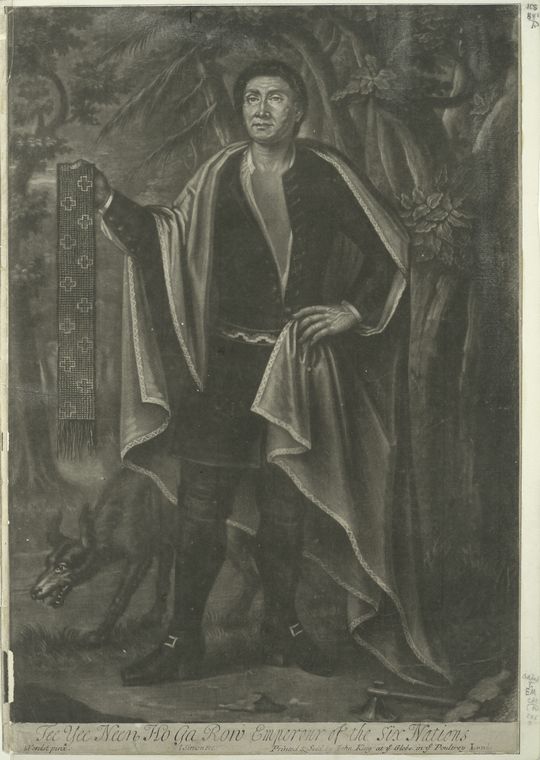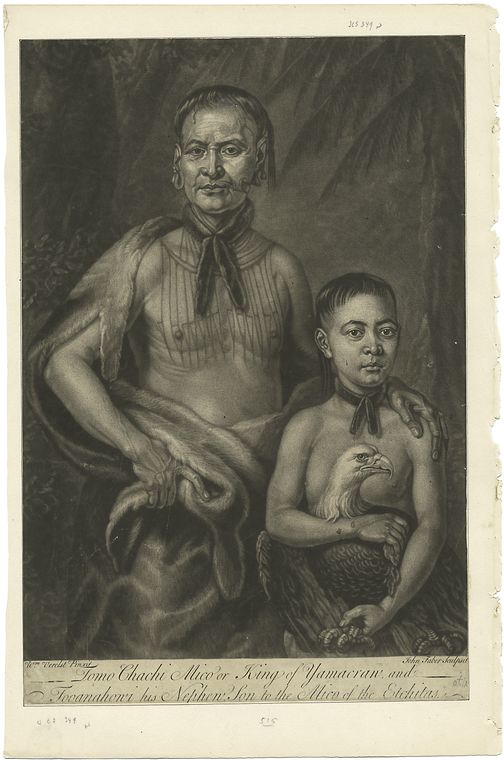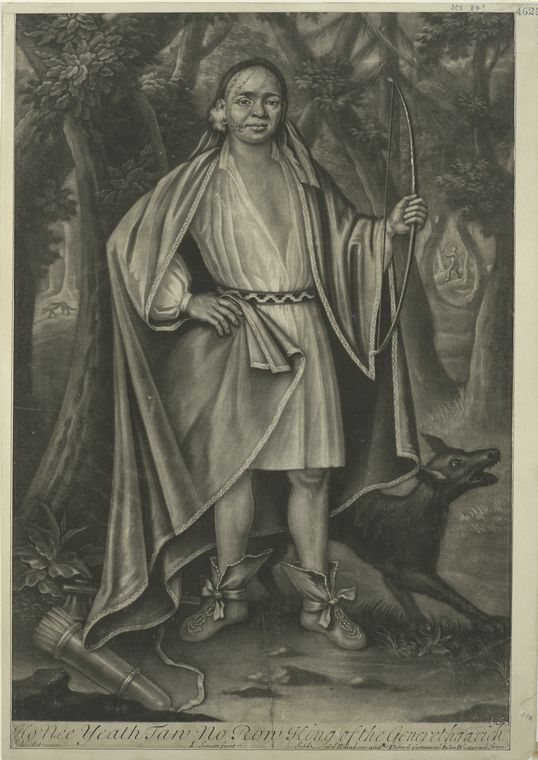Introduction
While many Native peoples tried to remain neutral in the conflict between the colonists and the British, others made the difficult decision to choose a side. The relationship with the colonists was marked by violence and continued intrusion on to Native land, leading most Native communities to side with the British. In retaliation, a detachment of the Continental Army sought to eliminate Native American groups in a brutal campaign in modern-day Ohio and Michigan.
After the war, British protection vanished and the genocide and displacement of Native Americans continued.
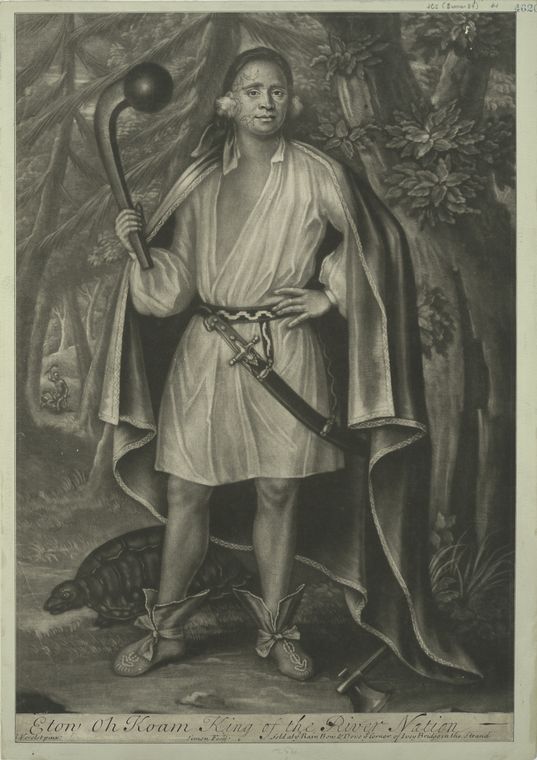
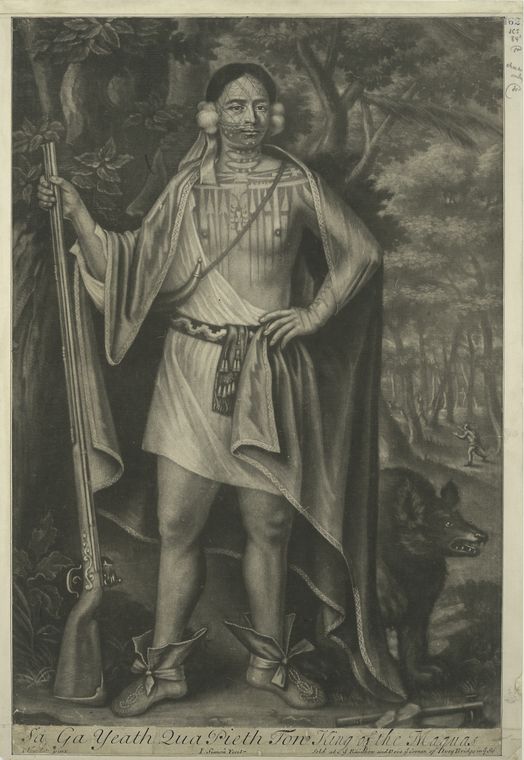
From right to left: Etow Oh Koam, King of the River Nation; Sa Ga Yeath Qua Pieth Tow King of the Maquas; Tee Yee Neen Ho Ga Row, Emperour of the Six Nations; Tomo Chachi Mico or King of Yamacraw, and Tooanahowi his nephew, son to the Mico of the Etchitas; Ho Nee Yeath Taw No Row, King of the Generethgarich
NYPL Digital Collections Image ID 423049; NYPL Digital Collections Image ID 421912; NYPL Digital Collections Image ID 421913; NYPL Digital Collections Image ID 421544; NYPL Digital Collections Image ID 421911
Language Use
It's important to be intentional in the words we use to describe indigenous people and histories. Take time to learn and use accurate terms specific to the community.
What We Say Matters: The Power of Words in American and Indigenous Histories, Bryan C. Rindfleisch
The Impact of Words and Tips for Using Appropriate Terminology: Am I Using the Right Word?, National Museum of the American Indian
More Archival Collections
To locate primary sources, consider archives with specialized collections.
- National Museum of the American Indian, Smithsonian Libraries and Archives
- Indians/Native Americans, National Archives
- Patriots of Color Archive, Museum of American Revolution
- Native American Archives, American Revolution Institute
- Center for Native American and Indigenous Research, American Philosophical Society Archives
Or, search ArchiveGrid for archival collections of more than 1,400 institutions including libraries, museums, and historical societies.
Examples of Primary Sources
- Concouguash, Chief Francis Joseph Neptune, Passamaquoddy tribe, allied with American colonists to fight the British, map of the Cobscook River area on July 12th, 1798
- Passamaquoddy Indian papers, #9014. Division of Rare and Manuscript Collections, Cornell University Library.
- Oneida Declaration of Neutrality
Subject Search Terms and Recommended Titles
Find resources in the NYPL Research Catalog by keyword searches or try the following subjects:
- Indians of North America > History > 18th century
- United States > History > Revolution, 1775-1783 > Participation, Indian
- Indians of North America > Government relations > To 1789
Want to find these books at a library near you? Try searching WorldCat!
Cherokee Women by
Call Number: HBC 98-4655ISBN: 0803237162Publication Date: 1998-03-01Theda Perdue examines the roles and responsibilities of Cherokee women during the eighteenth and nineteenth centuries, a time of intense cultural change. While building on the research of earlier historians, she develops a uniquely complex view of the effects of contact on Native gender relations, arguing that Cherokee conceptions of gender persisted long after contact. Maintaining traditional gender roles actually allowed Cherokee women and men to adapt to new circumstances and adopt new industries and practices.The Indian World of George Washington by
Call Number: JFE 18-8599ISBN: 9780190652166Publication Date: 2018-04-06George Washington's place in the foundations of the Republic remains unrivalled. His life story--from his beginnings as a surveyor and farmer, to colonial soldier in the Virginia Regiment, leader of the Patriot cause, commander of the Continental Army, and finally first president of the United States--reflects the narrative of the nation he guided into existence. There is, rightfully, no more chronicled figure. Yet American history has largely forgotten what Washington himself knew clearly: that the new Republic's fate depended less on grand rhetoric of independence and self-governance and more on land--Indian land. Colin G. Calloway's biography of the greatest founding father reveals in full the relationship between Washington and the Native leaders he dealt with intimately across the decades: Shingas, Tanaghrisson, Guyasuta, Attakullakulla, Bloody Fellow, Joseph Brant, Cornplanter, Red Jacket, and Little Turtle, among many others. Using the prism of Washington's life to bring focus to these figures and the tribes they represented--the Iroquois Confederacy, Lenape, Miami, Creek, Delaware--Calloway reveals how central their role truly was in Washington's, and therefore the nation's, foundational narrative.Scars of Independence by
ISBN: 9780804137287Publication Date: 2017-05-09When we think of the American Revolution, we think of brave patriots coming together to resist a tyrannical ruler in defense of noble ideals. It's a stirring narrative, and one the founders did their best to encourage after the war. But as historian Holger Hoock argues, the truth is far more complex- the Revolution was not only a high-minded battle over principles, but also a profoundly violent civil war-one that shaped the nation in ways we have only begun to understand. In Scars of Independence, Hoock writes the violence back into the story. American Patriots tortured Loyalists and imprisoned them in Connecticut mines; British troops massacred enemy soldiers, raped colonial women, and crowded half-starving prisoners on disease-ridden ships; both sides conscripted African-Americans, who suffered disproportionately as soldiers and slaves; and Washington's army waged a genocidal campaign against the Iroquois nations.Masters of Empire by
ISBN: 9780809029532Publication Date: 2015-12-08InMasters of Empire, the historian Michael A. McDonnell reveals the pivotal role played by the native peoples of the Great Lakes in the history of North America. Though less well known than the Iroquois or Sioux, the Anishinaabeg, who lived across Lakes Michigan and Huron, were equally influential.Masters of Empire charts the story of one group, the Odawa, who settled at the straits between those two lakes, a hub for trade and diplomacy throughout the vast country west of Montreal known as thepays d'en haut. Highlighting the long-standing rivalries and relationships among the great Indian nations of North America, McDonnell shows how Europeans often played only a minor role in this history, and reminds us that it was native peoples who possessed intricate and far-reaching networks of commerce and kinship, of which the French and British knew little. As empire encroached upon their domain, the Anishinaabeg were often the ones doing the exploiting. By dictating terms at trading posts and frontierforts, they played a crucial part in the making of early America. Through vivid depictions--all from a native perspective--of early skirmishes, the French and Indian War, and the American Revolution,Masters of Empire overturns our assumptions about colonial America.
